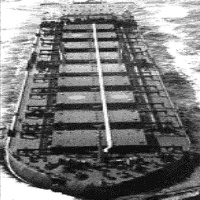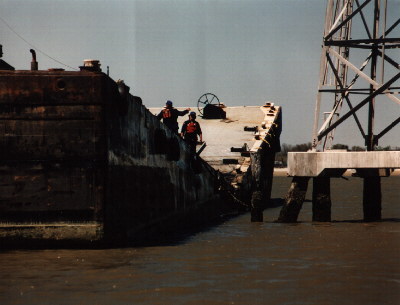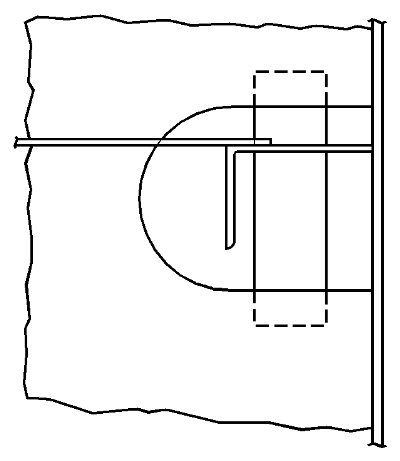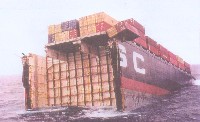



|
 The Ship Structures Committee has selected the following case studies which it hopes represent a wide range of structural failures, casualties and solutions. The goal of this site is to increase appreciation of structural issues that are unique to the shipbuilding industry and provide a forum for the dissemination of information to universities and practicing naval architects.
The Ship Structures Committee has selected the following case studies which it hopes represent a wide range of structural failures, casualties and solutions. The goal of this site is to increase appreciation of structural issues that are unique to the shipbuilding industry and provide a forum for the dissemination of information to universities and practicing naval architects.
|
 | Case Study I: NEW CARISSA
Date: February 3, 1999
Summary: The NEW CARISSA dragged anchor and grounded approximately 300 yards off a stretch of remote, undeveloped sandy beach 3 miles north of Coos Bay, Oregon. Within hours, the vessel was fully broached (broadside) to the incoming seas with approximately 400,000 gallons of fuel onboard. The grounding and subsequent recovery attempts created a catastrophic failure of the hull girder in two-mode global cyclic bending (MORE) |
 | Case Study II: DERBYSHIRE
Date: September 9, 1980
Summary: This paper discusses two possible explanations for the loss of the British OBO MV DERBYSHIRE during a severe storm at sea. Both explanations postulate foundering due to structural failure of critical components. One scenario assumes the breakup of the ship due to fatigue failure of longitudinal structural members in the aft portion of the ship, while the other assumes foundering resulting from collapse of hold covers under sea loading. (MORE) |
 | Case Study III: BUFFALO 292 & 286
Date: March 17, 1996 & May 1996
Summary: This report analyses two independent incidents where barges of similar construction and arrangements, suffered identical damage. In both incidents the vessels were transiting when the deck buckled separating the #2 and #3 cargo tanks. The analysis concluded that inland barges may be experiencing "progressive damage," where the vessel is loaded and unloaded in such a way that the bending stresses exceed the elastic limit and permanent deflections are created while degrading the strength. (MORE) |
 | Case Study IV: USS RADFORD
Date: February 5, 1999
Summary: Following a broad side collision at sea, the USS Radford experienced significant structural damage and flooding. Post damage inspections indicated that flooding was complete (free-flooded to the waterline). This report analysis the steps to stabilize the vessel for transit/repair and shows how POSSE was used to evaluate the ship's stability and structural strength. (MORE)
 | Case Study V: Container Ship
Date:
Summary: This report details the analysis of a pattern of structural failures throughout a class of three container ships. The analysis established the failure scenarios and determined the root cause of the progressive failure to be poor detailed design. Based on the analysis a design modification was developed and turned into a dry-dock repair specification to (MORE) |
 | Case Study VI: VALDIVIA
Date: May 17, 1997
Summary: The LST 93 VALDIVIA ran aground after an engine failure during beaching exercises. The hull girder experienced longitudinal buckling along the keel and the seaward sideshell. The buckling was caused by the unusual load condition of having the hull supported by the beach on the port side, while the sea continuously impacted the starboard side. This report details the structural modeling to assess the effects of this hull damage on residual strength and the subsequent salvage response (MORE) |
 | Case Study VII: Ex-CG20 (R.K. TURNER)
Date: July 5, 1998
Summary: This case study provides the U.S. Navy's analysis of a Live Fire Test and Evaluation (LFT&E) Weapons Effects Testing on the Ex-CG20 (Richmond K. Turner). The main purposes of the test was to accumulate threat weapons blast/fragmentation effects data from selected DD21 threat weapons (anti-ship missiles), and to provide data and observations on the behavior of a ship damaged by weapons effects and put under tow in low sea state conditions. The report provides a detailed description of the resulting structural failure (MORE)
|
 | Case Study IX: MSC CARLA
Date: July 5, 1998
Summary: The hull of MSC CARLA broke apart at the forward end of the new midbody. The bow portion sank after five days. The stern was towed into port. (MORE | PDF Version) |
 | Case Study X: BULK CARRIERS
Date: 1970's
Summary: This case study summarizes common design, operation, and maintenance practices on board bulk carriers that contribute to on-going hazards. Operationally, bulkers are loaded very rapidly;however, when unloading, heavy equipment is used that can be tough on coatings and plating. Once the coating has been compromised many cargoes can be corrosive to the steel beneath. (PDF Version) |
 | Case Study XI: RMS TITANIC
Date: April 14, 1912
Summary: The wreck of RMS Titanic is arguably the most famous marine casualty of modern times. On April 14, 1912 during her maiden voyage, RMS Titanic struck an iceberg southeast of Newfoundland, Canada. She floated for approximately two hours, eventually assuming an extreme trim by the bow and breaking in half. (PDF Version) |
 | Case Study XII: PRESTIGE
Date: N/A
Summary: Flooding in the ship's starboard #2 aft and #3 wing tanks caused a 25 degree list, which was counter-ballasted by flooding #2 aft port and #3 port ballast tanks. This resulted in an overstressed hull girder which failed after 6 days of exposure to heavy seas, causing theship to break in two and sink. (PDF Version) |
 | Case Study XIII: DOUBLE HULL TANK BARGES
Date: N/A
Summary: As mandated by the Oil Pollution Act of 1990, all single hull tank vessels, including barges will be phased out by 2015. Because complete replacement of the fleet with new barges is clearly not feasible, many operators are opting to retrofit their single hull barges to double hull. (PDF Version) |
 | Case Study XIV: R/V WESTERN FLYER
Date: July 5, 1998
Summary: R/V Western Flyer has experienced localized cracking to its aluminum structure during typical operations during virtually all of its twelve year life span. Various modifications have been implemented in an attempt to solve this problem. (MORE | PDF Version) | |
Graphics and Text Copyright © 2000, United States Coast Guard. All Rights Reserved.
All photographs in the NEW CARISSA Case Study are provided courtesy of OregonLive.com.
All photographs in the MV DERBYSHIRE Case Study are provided courtesy of Daniel Tarman & Edgar Heitman.
All photographs in the BUFFALO 292 & 286 Case Study are provided courtesy of PA3 Tyler Johnson, USCG.
All photographs and illustrations in the USS RADFORD Case Study are provided courtesy of LCDR Jeff Stettler, US Navy.
All illustrations in the Container Ship Case Study are provided courtesy of William A. Wood, Seaworthy Systems, Inc..
|
|

 Wednesday,
07/02/2025
Wednesday,
07/02/2025



 Wednesday,
07/02/2025
Wednesday,
07/02/2025





